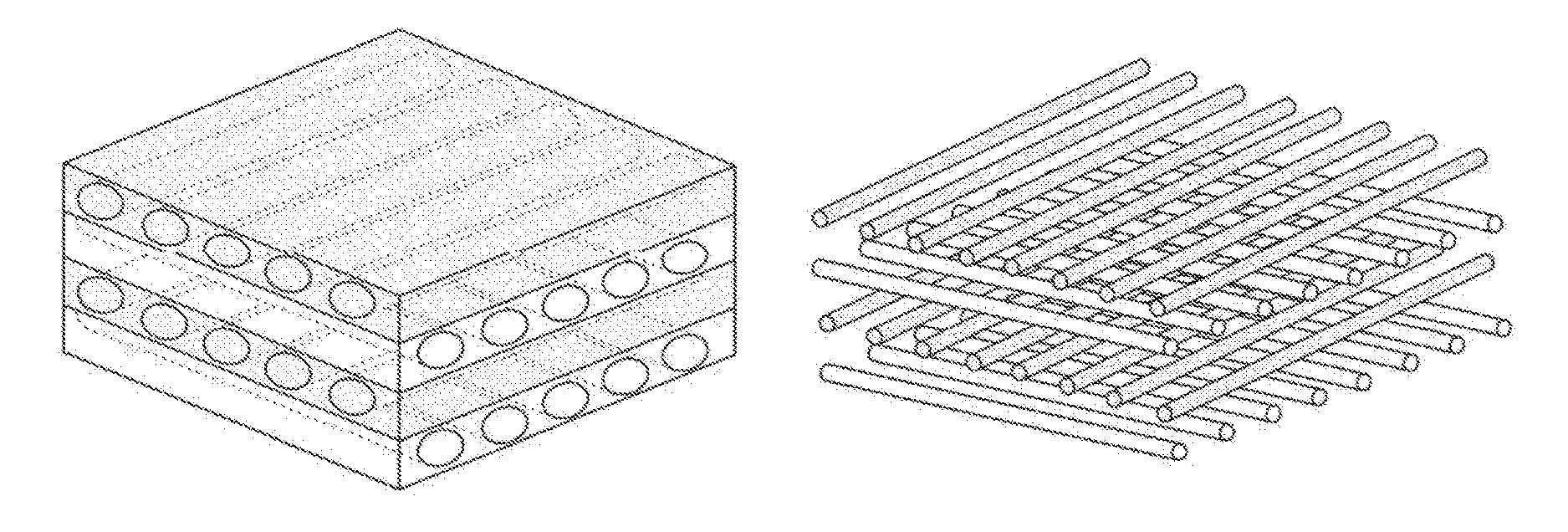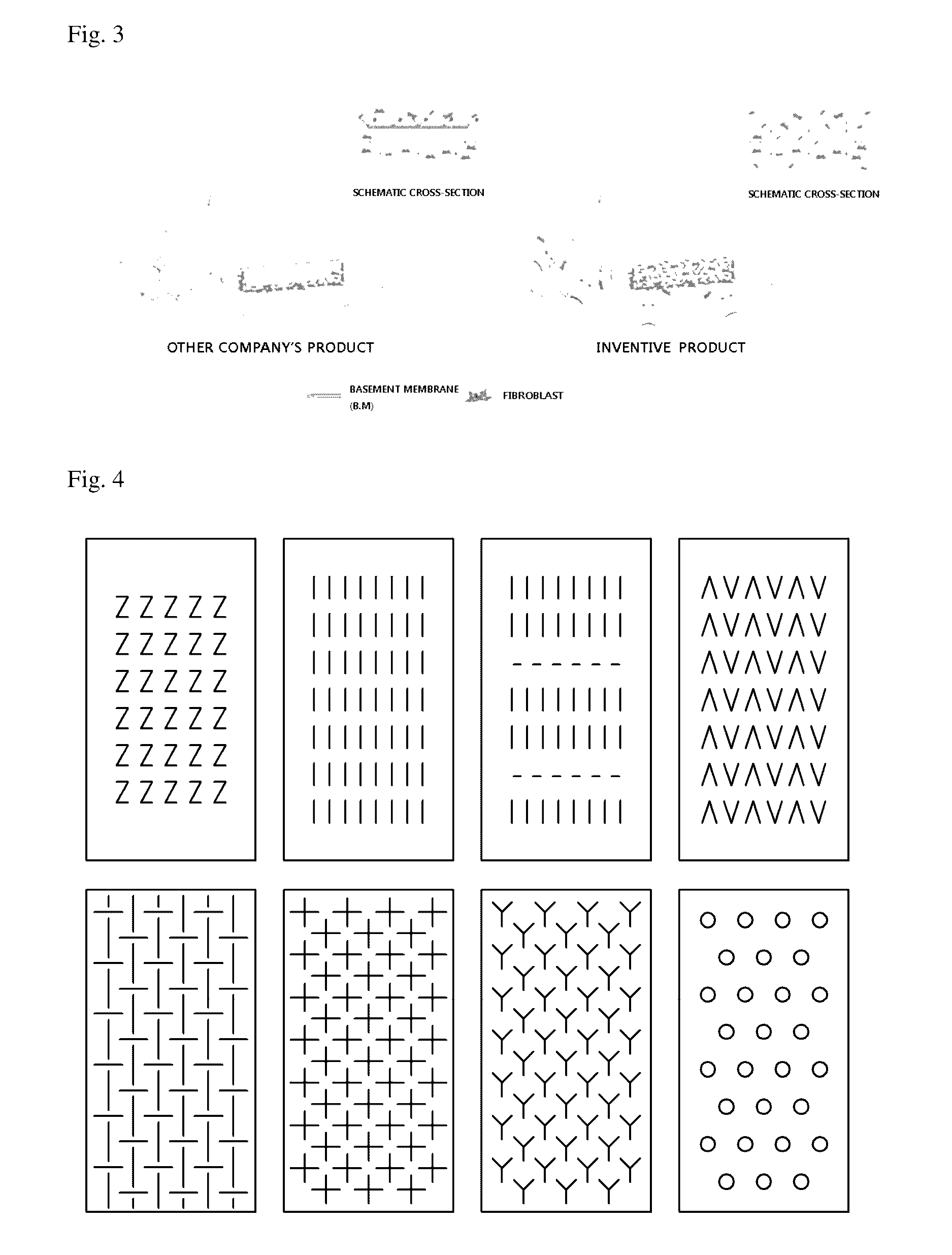Acellular dermal graft
a dermal graft and cell technology, applied in the direction of skin implants, etc., can solve the problems of unfavorable environment for transplantation, and achieve the effect of enhancing tissue extensibility and flexibility, and performing stably
- Summary
- Abstract
- Description
- Claims
- Application Information
AI Technical Summary
Benefits of technology
Problems solved by technology
Method used
Image
Examples
example 1
Preparation of Acellular Dermal Graft Having Corners Slope-Cut Therein
[0135]A skin tissue (extracted from a corpse donated from the Tissue Bank for nonprofit treatment of patients) was treated with a neutral protease, dispase, at a concentration of 1.0 units / ml, stirred at a temperature of 37° C. for 60 to 120 minutes in a shaking incubator, and then washed three times with sterile distilled water to separate an epidermis and a dermis. Then, the epidermis was removed.
[0136]The resulting epidermis-free tissue was treated with a 1% Triton X-100 solution at 30° C. for 100 minutes to remove dermal cells. For the epidermis-free dermis, a 10% dextran solution was used as a freezing solution. Then, the dermal tissue was dipped in the freezing solution at −4° C. for 12 hours to promote penetration of the freezing solution, stored for 12 hours in a deep freezer with a temperature of −70° C. or less, and lyophilized for 48 hours in a freeze dryer.
[0137]Next, corner portions of a graft (dermal...
example 2
Preparation of Multi-Slit-Treated Acellular Dermal Graft
[0138]A skin tissue (extracted from a corpse donated from the Tissue Bank for nonprofit treatment of patients) was treated with a neutral protease, dispase, at a concentration of 1.0 units / ml, stirred at a temperature of 37° C. for 60 to 120 minutes in a shaking incubator, and then washed three times with sterile distilled water to separate an epidermis and a dermis. Then, the epidermis was removed.
[0139]The resulting epidermis-free tissue was treated with a 1% Triton X-100 solution at 30° C. for 100 minutes to remove dermal cells.
[0140]To form a multi-slit pattern on the epidermis-free dermis, a blade was used to manually perform a process of forming slits in a longitudinal or transverse direction (see FIGS. 4 and 8).
[0141]A 10% dextran solution was used as the freezing solution. Then, the dermal tissue was dipped in the freezing solution at −4° C. for 12 hours to promote penetration of the freezing solution, stored for 12 hou...
example 3
Preparation of Vertical-Axis Circular Multi-Puncture-Treated Acellular Dermal Graft
[0143]A skin tissue (extracted from a corpse donated from the Tissue Bank for nonprofit treatment of patients) was treated with a neutral protease, dispase, at a concentration of 1.0 units / ml, stirred at a temperature of 37° C. for 60 to 120 minutes in a shaking incubator, and then washed three times with sterile distilled water to separate an epidermis and a dermis. Then, the epidermis was removed.
[0144]The resulting epidermis-free tissue was treated with a 1% Triton X-100 solution at 30° C. for 100 minutes to remove dermal cells.
[0145]To form a multi-puncture pattern on the epidermis-free dermis, the dermis was immobilized in corner portions using a multiple needle layer, and penetrations were performed in vertical direction to form multiple punctures.
[0146]A 10% dextran solution was used as the freezing solution. Then, the dermal tissue was dipped in the freezing solution at −4° C. for 12 hours to ...
PUM
 Login to View More
Login to View More Abstract
Description
Claims
Application Information
 Login to View More
Login to View More - R&D
- Intellectual Property
- Life Sciences
- Materials
- Tech Scout
- Unparalleled Data Quality
- Higher Quality Content
- 60% Fewer Hallucinations
Browse by: Latest US Patents, China's latest patents, Technical Efficacy Thesaurus, Application Domain, Technology Topic, Popular Technical Reports.
© 2025 PatSnap. All rights reserved.Legal|Privacy policy|Modern Slavery Act Transparency Statement|Sitemap|About US| Contact US: help@patsnap.com



